Alignment
- The sealing faces of the two stub-ends in a joint should contact each other, or in the case of rubber gasketed joint, they should be parallel to each other all around the circumference and in full contact (see lines A–A, B–B, C–C in Fig. 1 and 2).
- The IPP Deltaflex® flange face D–D (see Fig. 3) should be in full contact with the upper face of the stub-end all around the circumference to avoid fulcrum effect, which will lead to leaking and even breaking of the flange itself while torqueing the bolts.


